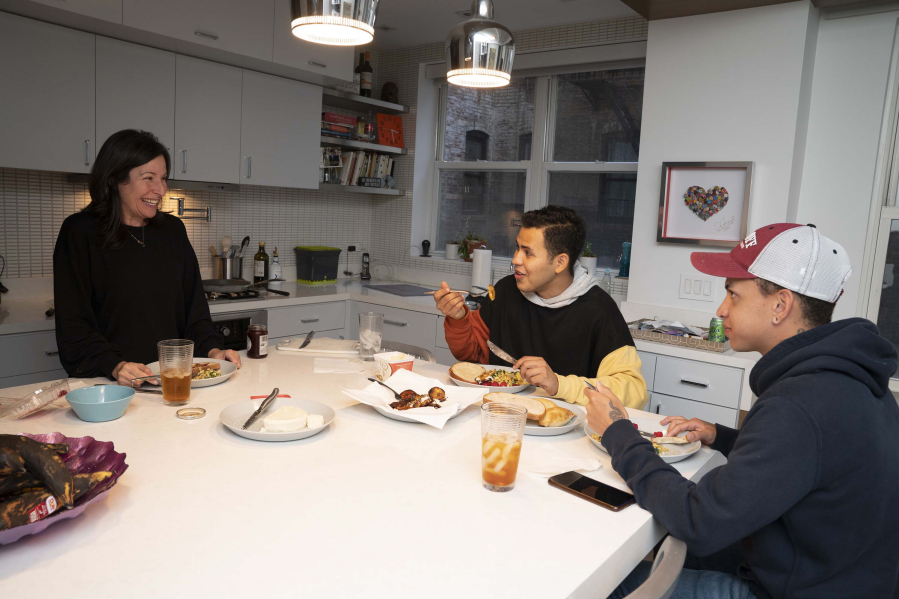NEW YORK — Melanie Van Orden is a volunteer with NYC ICE Watch, a mutual aid group working with the migrants flooding into the city. One night, late, she got a text: A group of migrants was wandering the city looking for a place to stay the night.
The six young men had arrived in New York a few days earlier, sleeping on the streets after being turned away from the 30th Street homeless intake shelter, Van Orden said. They met volunteers on Randall’s Island.
“This was the third night and they didn’t want to sleep on the street again,” Van Orden said.
The migrant crisis has officially become an emergency in New York City, with Mayor Eric Adams recently declaring the city does not have the space to adequately house the massive influx of South and Central American refugees. More than 17,000 migrants have pushed the city’s shelter system to nearly 100% capacity.
But some New Yorkers, more quietly, are helping solve the problem on a smaller scale. They’re opening their own homes, trying to offer what they can in an extraordinary moment.
Van Orden thought quickly. Her apartment was empty: She was planning on staying with a friend that night, and her daughter was staying with her dad for five days. She leaped into action, finding someone who could speak Spanish and grabbing protein bars and bottled water for the migrants.
“They were really hungry and thirsty when we got out there,” she said. “I was worried that they hadn’t had access to a bathroom or water for a long time. The shelter wouldn’t let them use the bathroom or have any water. It was pretty sad. … They all had colds, they had sore throats and really bad coughs.”
Van Orden crammed everyone in her car and drove them to her Bedford-Stuyvesant apartment, where they stayed for five days.
“We’re one of the richest cities in the world and we have plenty of money to spend on what we care about,” she said. “And we spend money — too much money — on some things and not enough on others. And one of the things that we don’t spend enough money on is taking care of each other and taking care of people that really need help.
“We could do it if we wanted to. We could do a much better job than we’re doing. And the city could set its budget priorities accordingly if it wanted to.”
Van Orden is far from the only one. Nonprofits, church groups, mutual aid groups and other volunteers have been working to fill the gaps in government response since the first buses dispatched by Texas Gov. Greg Abbott pulled into Port Authority.
They’ve spread by word of mouth and provide beds, showers, food, clothes, food, toiletries, legal help for migrants, as well as tickets to migrants’ intended destinations.
On a recent weekday evening on the Upper West Side, Candice Braun rifled through her apartment, searching for a toothbrush and razor for a migrant spending the night in her spare bedroom.
Braun has hosted a half-dozen migrants in recent weeks. None of them intended New York to be their final destination. Braun takes them in for a night, gives them a meal and a comfy bed, and then a ride to the airport or back to Port Authority, where they go off to places like Chicago; Bakersfield, California; Chattanooga, Tennessee, where they have friends, family or leads on jobs.
“I guess we’re running a little youth hostel here for 19- to 22-year-olds,” Braun joked. “ … It’s just been really nice to be able to give them, after their horrendous journey, a warm kind of homey experience”
Braun is a volunteer with Team TLC NYC, who has sponsored plane and bus tickets themselves without being compensated by the city. The group, which is an affiliate of Grannies Respond, has spent more than $60,000 in tickets alone.
“It’s a huge group effort of people just pitching in and wanting to help,” Braun said. “ … You know, if it wasn’t for the money, it would be totally fine.”
Two of Braun’s children are away at college, giving her the free bedrooms and fridge space to host others.
“I think that it’s an easy way to help someone who’s super vulnerable, you know? It’s like being an aunt for a couple of days. I mean, it gives them more hope and faith and humanity when people are nice to them,” Braun said.
Advocates and officials have criticized Mayor Eric Adams for his plan to place migrants in a tent camp on Randall’s Island for a lack of plans to transition people out of the shelter system.
“I think it is easy to despair over a lack of formalized coordinated response from the federal government, the state government and the city government,” Rev. Lea Matthews, who hosts five migrants at St. Paul and St. Andrew United Methodist Church, said. She coordinates the efforts of a network of 288 volunteers.
Matthews thought the Upper West Side church would serve as just a temporary way station for migrants passing through New York. It became a more lasting project when she realized the city wouldn’t help transition the migrants into permanent housing.
“What is hardest to stomach, certainly as a person of faith, is that human beings are treated in this horrible way so cavalierly, so chaotically,” Matthews said. “That is the part that is hardest to witness. But I will say that into that gap, seeing people respond, huge amounts of people responding out of compassion and out of care where the government is not — that is heartening.”



